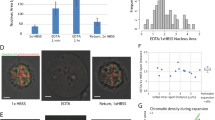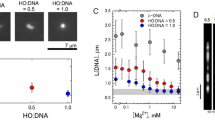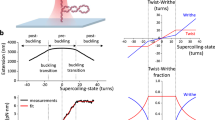Abstract
Magnetic tweezers were used to study the mechanical response under torsion of single nucleosome arrays reconstituted on tandem repeats of 5S positioning sequences. Regular arrays are extremely resilient and can reversibly accommodate a large amount of supercoiling without much change in length. This behavior is quantitatively described by a molecular model of the chromatin three-dimensional architecture. In this model, we assume the existence of a dynamic equilibrium between three conformations of the nucleosome, corresponding to different crossing statuses of the entry/exit DNAs (positive, null or negative, respectively). Torsional strain displaces that equilibrium, leading to an extensive reorganization of the fiber's architecture. The model explains a number of long-standing topological questions regarding DNA in chromatin and may provide the basis to better understand the dynamic binding of chromatin-associated proteins.
Note: In the supplementary information initially published online to accompany this article, Supplementary Figure 2 was mistakenly replaced by Supplementary Equation 2. The error has been corrected online.
This is a preview of subscription content, access via your institution
Access options
Subscribe to this journal
Receive 12 print issues and online access
$209.00 per year
only $17.42 per issue
Buy this article
- Purchase on SpringerLink
- Instant access to full article PDF
Prices may be subject to local taxes which are calculated during checkout







Similar content being viewed by others
Change history
30 April 2006
Figure incorrect and author name incorrect in pubmed
References
VanHolde, K.E. Chromatin (Springer-Verlag, New York, 1988).
Luger, K., Mader, A.W., Richmond, R.K., Sargent, D.F. & Richmond, T.J. Crystal structure of the nucleosome core particle at 2.8 A resolution. Nature 389, 251–260 (1997).
Germond, J.E., Hirt, B., Oudet, P., Gross-Bellark, M. & Chambon, P. Folding of the DNA double helix in chromatin-like structures from simian virus 40. Proc. Natl. Acad. Sci. USA 72, 1843–1847 (1975).
Wolffe, A. Chromatin (Academic Press, London, 1998).
Cui, Y. & Bustamante, C. Pulling a single chromatin fiber reveals the forces that maintain its higher-order structure. Proc. Natl. Acad. Sci. USA 97, 127–132 (2000).
Brower-Toland, B.D. et al. Mechanical disruption of individual nucleosomes reveals a reversible multistage release of DNA. Proc. Natl. Acad. Sci. USA 99, 1960–1965 (2002).
Hayes, J.J. & Hansen, J.C. New insights into unwrapping DNA from the nucleosome from a single-molecule optical tweezers method. Proc. Natl. Acad. Sci. USA 99, 1752–1754 (2002).
Strick, T.R., Allemand, J.F., Bensimon, D., Bensimon, A. & Croquette, V. The elasticity of a single supercoiled DNA molecule. Science 271, 1835–1837 (1996).
Simpson, R.T., Thoma, F. & Brubaker, J.M. Chromatin reconstituted from tandemly repeated cloned DNA fragments and core histones: a model system for study of higher order structure. Cell 42, 799–808 (1985).
Prunell, A. & Sivolob, A. Paradox lost: nucleosome structure and dynamics by the DNA minicircle approach. in Chromatin Structure and Dynamics: State-of-the-Art Vol. 39 (eds. Zlatanova, J. & Leuba, S.H.) 45–73 (Elsevier, London, 2004).
Catez, F. et al. Network of dynamic interactions between histone H1 and high-mobility-group proteins in chromatin. Mol. Cell. Biol. 24, 4321–4328 (2004).
Phair, R.D. et al. Global nature of dynamic protein-chromatin interactions in vivo: three-dimensional genome scanning and dynamic interaction networks of chromatin proteins. Mol. Cell. Biol. 24, 6393–6402 (2004).
McBryant, S.J. et al. Preferential binding of the histone (H3–H4)2 tetramer by NAP1 is mediated by the amino-terminal histone tails. J. Biol. Chem. 278, 44574–44583 (2003).
Leuba, S.H. et al. Three-dimensional structure of extended chromatin fibers as revealed by tapping-mode scanning force microscopy. Proc. Natl. Acad. Sci. USA 91, 11621–11625 (1994).
Bouchiat, C. & Mezard, M. Elasticity model of a supercoiled DNA molecule. Phys. Rev. Lett. 80, 1556–1559 (1998).
Ben-Haim, E., Lesne, A. & Victor, J.M. Chromatin: a tunable spring at work inside chromosomes. Phys. Rev. E Stat. Nonlin. Soft Matter Phys. 64, 051921 (2001).
Schiessel, H., Gelbart, W.M. & Bruinsma, R. DNA folding: structural and mechanical properties of the two-angle model for chromatin. Biophys. J. 80, 1940–1956 (2001).
Woodcock, C.L., Grigoriev, S.A., Horowitz, R.A. & Whitaker, N. A chromatin folding model that incorporates linker variability generates fibers resembling native structures. Proc. Natl. Acad. Sci. USA 90, 9021–9025 (1993).
Barbi, M., Mozziconacci, J. & Victor, J.M. How the chromatin fiber deals with topological constraints? Phys. Rev. E Stat. Nonlin. Soft Matter Phys. 71, 031910 (2005).
Schalch, T., Duda, S., Sargent, D.F. & Richmond, T.J. X-ray structure of a tetranucleosome and its implications for the chromatin fiber. Nature 436, 138–141 (2005).
De Lucia, F., Alilat, M., Sivolob, A. & Prunell, A. Nucleosome dynamics. III. Histone tail-dependent fluctuation of nucleosomes between open and closed DNA conformations. Implications for chromatin dynamics and the linking number paradox. A relaxation study of mononucleosomes on DNA minicircles. J. Mol. Biol. 285, 1101–1119 (1999).
Bednar, J. et al. Nucleosomes, linker DNA, and linker histone form a unique structural motif that directs the higher order folding and compaction of chromatin. Proc. Natl. Acad. Sci. USA 95, 14173–14178 (1998).
Goulet, I., Zivanovic, Y., Prunell, A. & Revet, B. Chromatin reconstitution on small DNA rings. I. J. Mol. Biol. 200, 253–266 (1988).
Luger, K. & Richmond, T.J. DNA binding within the nucleosome core. Curr. Opin. Struct. Biol. 8, 33–40 (1998).
Sivolob, A., De Lucia, F., Revet, B. & Prunell, A. Nucleosome dynamics. II. High flexibility of nucleosome entering and exiting DNAs to positive crossing. An ethidium bromide fluorescence study of mononucleosomes on DNA minicircles. J. Mol. Biol. 285, 1081–1099 (1999).
Sivolob, A., Lavelle, C. & Prunell, A. Sequence-dependent nucleosome structural and dynamic polymorphism. Potential involvement of histone H2B N-terminal tail proximal domain. J. Mol. Biol. 326, 49–63 (2003).
Sivolob, A. & Prunell, A. Linker histone-dependent organization and dynamics of nucleome entry/exit DNAs. J. Mol. Biol. 331, 1025–1040 (2003).
Harada, Y. et al. Direct observation of DNA rotation during transcription by Escherichia coli RNA polymerase. Nature 409, 113–115 (2001).
Sarkar, A. & Marko, J.F. Removal of DNA-bound proteins by DNA twisting. Phys. Rev. E Stat. Nonlin. Soft Matter Phys. 64, 061909 (2001).
Shaw, S.Y. & Wang, J.C. Knotting of a DNA chain during ring closure. Science 260, 533–536 (1993).
Angelov, D., Vitolo, J.M., Mutskov, V., Dimitrov, S. & Hayes, J.J. Preferential interreaction of the core histone tail domains with linker DNA. Proc. Natl. Acad. Sci. USA 98, 6599–6604 (2001).
Klug, A. & Lutter, L.C. The helical periodicity of DNA on the nucleosome. Nucleic Acids Res. 9, 4267–4283 (1981).
Prunell, A. A topological approach to nucleosome structure and dynamics: the linking number paradox and other issues. Biophys. J. 74, 2531–2544 (1998).
Norton, V.G., Imai, B.S., Yau, P. & Bradbury, E.M. Histone acetylation reduces nucleosome core particle linking number change. Cell 57, 449–457 (1989).
Garner, M.M., Felsenfeld, G., O'Dea, M.H. & Gellert, M. Effects of DNA supercoiling on the topological properties of nucleosomes. Proc. Natl. Acad. Sci. USA 84, 2620–2623 (1987).
Clark, D.J., Ghirlando, R., Felsenfeld, G. & Eisenberg, H. Effect of positive supercoiling on DNA compaction by nucleosome cores. J. Mol. Biol. 234, 297–301 (1993).
Misteli, T., Gunjan, A., Hock, R., Bustin, M. & Brown, D.T. Dynamic binding of histone H1 to chromatin in live cells. Nature 408, 877–881 (2000).
Liu, L.F. & Wang, J.C. Supercoiling of the DNA template during transcription. Proc. Natl. Acad. Sci. USA 84, 7024–7027 (1987).
Bustin, M., Catez, F. & Lim, J.H. The dynamics of histone H1 function in chromatin. Mol. Cell 17, 617–620 (2005).
Hansen, J.C. & Lohr, D. Assembly and structural properties of subsaturated chromatin arrays. J. Biol. Chem. 268, 5840–5848 (1993).
Fulconis, R. et al. Twisting and untwisting a single DNA molecule covered by RecA protein. Biophys. J. 87, 2552–2563 (2004).
Meersseman, G., Pennings, S. & Bradbury, E.M. Mobile nucleosomes–a general behavior. EMBO J. 11, 2951–2959 (1992).
Mangenot, S., Leforestier, A., Durand, D. & Livolant, F. X-ray diffraction characterization of the dense phases formed by nucleosome core particles. Biophys. J. 84, 2570–2584 (2003).
Acknowledgements
The authors are grateful to G. Almouzni and J.P. Quivy for providing material in preliminary experiments, E. Ben-Haim and C. Bouchiat for discussions and K. Dorfman and A. Sivolob for critical reading. A.B., N.C.eS., G.W., C.L. and J.M. thank the French Ministry of Research for AC-MENRT fellowships. This work was supported by the Centre National de la Recherche Scientifique (A.P.'s and J.M.V.'s laboratories) and by grants from the Centre National de la Recherche Scientifique/Ministère de l'Education Nationale de la Recherche et de la Technologie DRAB programs and the Institut Curie Physics of the Cell cooperative program (J.L.V.'s laboratory).
Author information
Authors and Affiliations
Corresponding authors
Ethics declarations
Competing interests
The authors declare no competing financial interests.
Supplementary information
Supplementary Fig. 1
Regular and irregular fibers (PDF 227 kb)
Supplementary Fig. 2
The 'single-state' fiber (PDF 288 kb)
Supplementary Fig. 3
'Open-state' and 'positive-state' ideal fibers (PDF 297 kb)
Supplementary Fig. 4
The 'three-state' fiber (PDF 290 kb)
Supplementary Fig. 5
Plectoneme structures (PDF 764 kb)
Supplementary Equation 1
Length and topology. (PDF 179 kb)
Supplementary Equation 2
Gibbs free energy of a fiber containing nucleosomes fluctuating between 3 states. (PDF 19 kb)
Supplementary Equation 3
Proportion of nucleosomes in the negative state as a function of the external torque C. (PDF 171 kb)
Rights and permissions
About this article
Cite this article
Bancaud, A., Conde e Silva, N., Barbi, M. et al. Structural plasticity of single chromatin fibers revealed by torsional manipulation. Nat Struct Mol Biol 13, 444–450 (2006). https://doi.org/10.1038/nsmb1087
Received:
Accepted:
Published:
Issue Date:
DOI: https://doi.org/10.1038/nsmb1087



